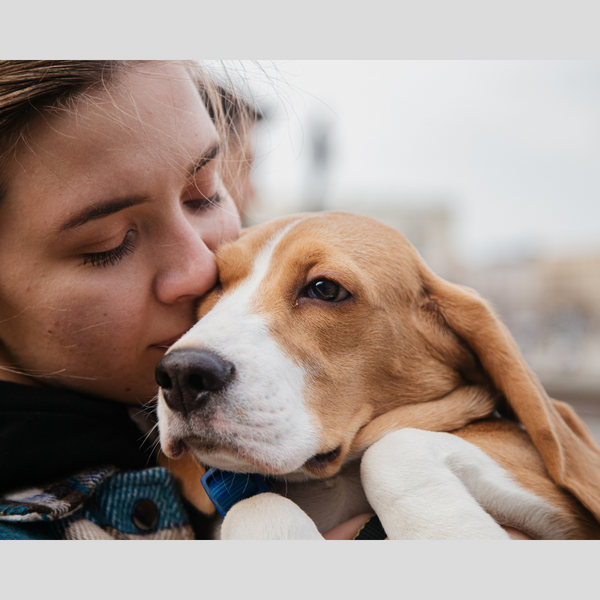
Hypoallergenic Pets - Top Breeds For Allergy Sufferers
(Dr. Iulia Miha, DVM) It can be frustrating when you or someone in your household suffers from pet allergies. If you are sensitive to pets but still want to have a furball at home, there are several breeds of dogs and cats that are considered hypoallergenic.
But first of all, let's learn more about what a pet allergy means and how it manifests itself.
What Does Having A Pet Allergy Mean?
In the last decade, the prevalence of pet allergies has increased. This has a significant impact on the quality of life of people who are allergic. A pet allergy is caused by contacting or inhaling the small particles that contain the allergens responsible for the appearance of clinical signs.
It is a myth that pet hair is to blame for triggering allergies. In fact, what causes the allergy in humans are the proteins found in the saliva, urine, and dander of pets in both dogs or cats. These small particles (allergens) remain suspended in the air and are very easily distributed on surfaces. This is most often where we come into contact with these allergens.
In dogs, the major allergens (Can f 1 and Can f 2) are represented by salivary lipocalin proteins. Can f 1 (Canis familiaris allergen 1) is produced by the epithelial tissue of the tongue, and Can f 2, is produced by the epithelial tissue of the tongue and the parotid gland (salivary gland). These allergens reach the dander and fur through the dog's saliva when they groom themselves.
In cats, the major allergen (Fel d 1 – Felis domesticus allergen 1) is represented by a secretoglobin (protein) that is produced by the perianal, lacrimal, sebaceous, and salivary glands. This allergen is found in dander and saliva. However, there is also Fel d 2 (serum albumin), d 3 (Cystatin A), and d 4 (lipocalin), these being found in dander, serum, and saliva for Fel d 2, in dander for d 3, and in saliva for d 4.
In conclusion, cats are likely to cause more allergic reactions than dogs.
How Do Pet Allergies Manifest in People?
Pet allergies can produce the same clinical signs as any other respiratory allergy:
- Itchy eyes
- Red eyes
- Watery eyes
- Nasal itching
- Runny nose
- Sneezing
- Nasal congestion
- Itchy throat or ears
In more severe cases, some people may develop clinical signs such as:
- Asthma
- Breathing difficulties
- Dry cough
- Whistling breath
- Chest pains
- Swelling of the eyelids
- Itchy skin
- Anaphylactic shock
If you are allergic, a prolonged or repeated exposure to a pet can cause ongoing inflammation of the airways. This leads to chronic clinical signs without these being clearly related to the pet. The nose and bronchi become more sensitive and react to other stimuli such as physical exercises, cold air, pollution, or dust, which would not normally cause clinical signs.
Hypoallergenic Breeds
Remember that a hypoallergenic breed does not indicate that it is allergen-free, they can still cause clinical signs of allergy. These breeds just produce less allergens than others.
Hypoallergenic Dog Breeds
- Shih Tzu
Although it is a fluffy animal, Shih Tzus are perfect pets for people with allergies. Their bodies are covered with long hair, which must be groomed frequently. They do not shed as much as other dogs, the hair falling only during brushing. In addition, they are an intelligent, affectionate, and friendly breed.
- Poodle
Poodles shed little or no hair. However, their coat requires a lot of grooming and care, and most people recommend using a professional groomer to maintain their coat and do fun hairstyles. Moreover, this breed is extremely intelligent and easy to train. Poodles make great pets!
- Chinese Crested Dog
This breed can be in two varieties: with or without fur. They are intelligent and affectionate dogs. The hairless variety does not require bathing or excessive care. Chinese crested dogs also bond closely with their owners and are very playful.
- Portuguese Water Dog
This breed sheds less than other dogs. It has curly fur that needs regular grooming. Dogs of this breed are great water lovers, tireless swimmers, and divers. They are recognized as "big chewers", so it is desirable to offer them enough objects to chew when they are left alone so they don't destroy your stuff. It is an intelligent dog that gets along well with children and strangers (if they are introduced to them beforehand).
- Mexican Hairless Dog (Xoloitzcuintli)
It is a rare, very intelligent breed, which stands out for the fact that it has no hair. Xolo dogs are calm and compact. The breed keeps its distance from strangers but is affectionate towards its family. If you don't socialize them from an early age, these dogs can become aggressive towards people or other pets.
- Bichon Frise
This breed is very popular among dog lovers. They have silky, dense, and curly fur that needs constant grooming. They have a friendly character and are very loving towards their owners. The Bichon Frise is an intelligent, playful, and energetic dog that gets along well with children or other pets.
- Yorkshire Terrier
This breed has a long, silky coat, which completely covers its legs. They are small dogs, very friendly and loving. However, they tend to overestimate themselves and become cheeky. For this reason, it is best to start controlling this behavior when they are puppies.
- Basenji
This breed has a fine, thick, and shiny coat. It is a suitable dog for experienced dog owners who are happy to have a companion with a mind of their own. It is a dog with an independent and very playful character, which can also be shy. They are a very intelligent and loyal breed.
- Schnauzer
This breed sheds less than other dogs. They have wiry fur and a bushy beard. Grooming Schnauzers is a bit more complicated than other breeds, and this is because their coarse fur not only requires regular grooming but also trimming at least two times a year. It is an intelligent and playful dog that likes to spend time with their owner.
Hypoallergenic Cat Breeds
- Sphynx
This cat breed is also called the hairless cat. The sphynx has almost no hair, only a fine fluff on the skin that is barely visible. Their skin is slightly wrinkled. Sphynx cats are intelligent, lively, and very affectionate. Most of them love to spend time with other animals and their owners.
- Siamese
Siamese cats are jokingly called cats' dogs because of their dog-like behavior. Their coat is short with a little undercoat. It is a loving but independent breed. They are very sociable animals that need interaction.
- Devon Rex
A characteristic feature of this breed is the wavy, short fur and large ears. They are very friendly cats, attached to their owners. Being easy to maintain, these cats are ideal for busy people.
- Cornish Rex
It is a very intelligent and playful breed that if it's not socialized will get bored and start acting out in ways that are not to the owner's liking. Their fur is very dense and short with a wavy texture and is made up of only transition hair without undercoat.
- Havana Brown Cat
It is an intelligent and playful breed that likes to be near its owner almost constantly. However, if there is something that does not suit them, Havana cats can become irritable. They have short and smooth fur that does not need intensive grooming.
- Peterbald
This cat breed can be completely bald or have fur variations. Like Sphynx cats, Peterbald do not tolerate temperature changes very well; they are exposed to both overheating and severe cooling of the body. It is an affectionate and loyal breed. It likes to spend time with family members, being a sociable breed. Peterbald is also a cheerful and lively breed.
Iuliana graduated from the University of Agronomical Sciences and Veterinary Medicine in 2012, Romania. She has a Master’s degree in Small Animal and Equines Pathology and a strong affinity for Veterinary Parasitology and Laboratory. In 2013 she started her Ph.D. in epithelial cancer in dogs and cats. She volunteered at the faculty’s clinic in her 3rd year of study, and continued her career in small animal pathology and laboratory. She has one cat and eleven rats. Her interests outside of work include traveling, writing, and crafting.

Post a Comment!